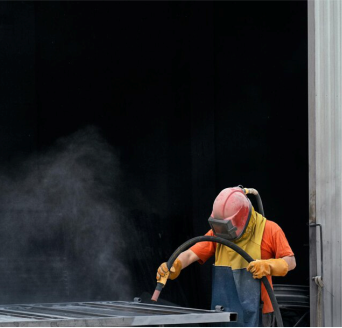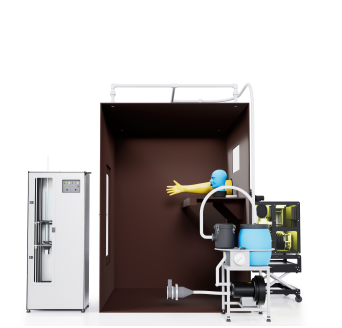Testing of self-rescuers with tested subjects
Testing of self-contained self-rescuers on chemically bound oxygen or compressed air with tested subjects is a mandatory procedure according to industrial standarts requirements.
It complements the basic assessment of the self-rescuer obtained by testing on ‘artificial lung’ type test equipment, e.g. on OXY ROBOT metabolic breathing simulator, and evaluates the self-rescuer according to the following criteria:
- level of protective properties;
- breathing conditions in the self-rescuer;
- physiological reactions of people to work in the self-rescuer;
- peculiarities of operation of the components and systems of the self-rescuer;
- convenience of using the self-rescuer.
To establish the assessment of self-rescuer performance according to the criteria described above, it is required to take breathing performance of the tested subjects in the tested RPE under different loads and in different conditions, to compare these parameters with the characteristics specified by the RPE designer and the requirements of standards and to assess the subjective feelings of the tested subject on the questionnaire.
The level of protective properties and peculiarities of the self-rescuer systems operation are determined by the following parameters:
- the volume concentration of CO2 (carbon dioxide) at the exhalation or a given sampling point;
- the volume concentration of O2 (oxygen) on inhalation or a given extraction point;
- breathing resistance on inhalation and exhalation;
- inhalation temperature.
Second Breath OÜ offers MOBILE BREATH RECORDER for testing self-rescuers. We have replaced the body of the test device and the kit is now a portable ergonomic measuring unit that sits on the belt of a tested subject, connects to the mouthpiece of the self-rescuer under test via a connector, records breathing parameters and transmits the data via Wi-Fi to the software on the test operator's personal computer.
In addition, a smartphone with an app is worn on the wrist of a tested subject, which reflects in a certain sequence a list of activities from the test programme. In this way, the test operator will have a record of how the breathing parameters of the self-rescuer changed during the individual exercises. Such information will help the self-rescuer designer to determine whether the RPE can withstand different loads and whether it is comfortable to work in it.

Fig. 1. Complete set of the mobile breath recorder

Fig. 2. Preparation for the test

Fig. 3. Performing exercises during a self-rescuer test

Fig.4. The operator controls the testing process remotely via Wi-Fi

Fig.5. The tested subject controls his breathing and the test program
The freedom and convenience of the test says a lot about the quality of the RPE, as limited test conditions do not allow to fully evaluate all the performance characteristics of the RPE and determine its safety level.
The wireless architecture of Second Breath's mobile breath recorder facilitates the testing process and enables the test to be conducted in the most realistic scenario possible, where a tested subject is not confined to a fixed base of test equipment and can perform actions as in the actual operation of the self-rescuer.
The test device is compatible with climate and smoke chambers, its ergonomics allows to perform the exercise programme in a sports zone, training mine, etc.

Fig. 6. Testing self-rescuer in a climatic chamber
Mobile breath recorder has a wide range of measurement capabilities (read the technical specifications on the product page, making it an indispensable tool for designers and manufacturers of self-rescuers, as well as for professional laboratories and certification bodies.
On request, the Second Breath team is ready to develop Mobile breath recorder for filtered types of RPE as well.




_342x328_4c7.jpg)









